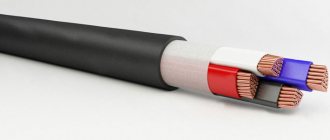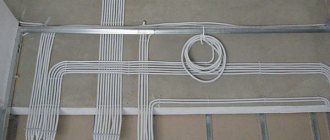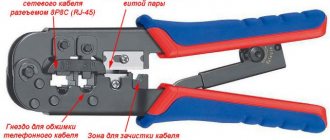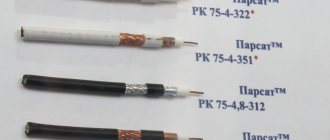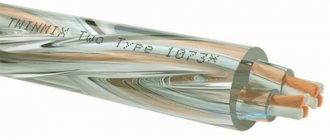Walking into an electrical store, the average person may feel dizzy from the assortment and number of cable varieties.
Two cables of the same brand may differ from each other, primarily in the cross-section of the cores, insulation thickness and composition. What is the reason?
The fact is that manufacturing plants may be guided by various regulatory documents. Previously, back in the days of the Union, factories produced cables in accordance with GOST, but recently the situation has changed dramatically.
In order to increase economic profit, our own technical specifications were developed, which prescribe the requirements for the cable manufacturing substance and the procedures governing the fulfillment of the requirements of the technical specifications. All this has led to the fact that today a person can purchase a wiring cable with a nominal cross-section of 4 mm2, but in fact will receive a cable with a cross-section of 3 mm2 at best . Next, dear readers, I will try to explain in simple and understandable language what the difference is between TU and GOST, and how not to be deceived.
Difference between GOST and TU cables
In Soviet times, factories always produced products in accordance with GOST.
GOST is a state standard from which you have no right to deviate. If the product said it was a 4mm² cable, then it really was a real 4mm². Much later, in order to increase the economic profit of the enterprise, their own technical conditions were invented. The technical specifications indicate the requirements for any substance from which the cable is made, as well as the procedures governing the implementation of these requirements.
On the one hand, there doesn’t seem to be much difference compared to GOST. However, this allowed the manufacturer to begin reducing the cross-section of the cores, the thickness of the insulation, etc. They simply issue technical specifications for one specific product and prescribe in them what they themselves require. As a result, you can observe the following difference between seemingly identical cable brands:
And all these deviations from GOST were prescribed by the plant in the technical specifications, thus allegedly not violating the standards.
There are two main methods used here:
- For example, you can seem to keep the cross-section, but save on burning copper, or add some impurities to it.
- The second method is if you can provide sufficient resistance to the core, you are allowed to reduce its cross-section.
All this led to manipulation and dangerous savings in the manufacture of cable products.
When you think about saving when choosing a cable, know that there are two main violations when manufacturing it according to specifications:
- the cross-section of the cores is reduced
- the thickness of the insulating layer decreases
What does GOST say about product requirements?
So, I don’t want to bore you with boring and flowery language, so I’ll keep it simple. According to the requirements of GOST 22483-2012
, the main criterion for compliance with
GOST
is not the cross-section itself, but the electrical resistance.
Moreover, it is measured at a certain temperature and at a certain length of the core. Therefore, a slight deviation in one direction or another is permissible even according to GOST
, the main thing is that the resistance meets all the necessary standards.
Cable according to GOST
Then the question is - what is the same GOST cable expressed in? After the plant receives technical specifications for any cable, the plant reports this to the state. And the state, in turn, responds: “Okay, we see your technical conditions (TU). But we have our own ideas about the VVGng 3x2.5 cable. We want that there was such and such copper, such and such materials, they withstood such and such conditions, and so on. Will your cable meet our state standards (GOST)? If so, bring it to us for certification, we will check it, if everything is fine, then your cable will be made according to the GOST standard.”
What does this mean? It turns out that any cable complies with specifications, but not every specification complies with GOST. Therefore, if the label says “TU No...”, do not rush to swear and be indignant - any cable should have a TU. Let's imagine this situation. You spent a long time choosing a cable in the store, searching, analyzing. And here is some bad online store or, conversely, a good online store (for example, Molter). Next, you take a GOST or TU cable, pick up a ruler and measure the cross-section. Your heart slows down.. After all, the cable should have a cross-section of 3.5 mm... And even more so there is no such thing!
There is no need to worry right away for two reasons. Firstly, 2.5 mm is a square section, that is, the cutting area. If you decide to measure the diameter with a ruler (although it is better, of course, to use a caliper for this purpose), the resulting value must be squared and multiplied by 0.785.
Simply put, the square cross-section of the wire = Scr = 0.785d2, where d is the diameter of the cable. But even if you now measure the cable correctly, the output value for the cable may be 2.5, for example 2.3. You will exclaim - I am being deceived! But in reality this is again not the case. To understand this issue more deeply, we will turn to one of the GOSTs that cables must comply with. To do this, we will study GOST 22483-77.
This document describes what requirements a cable must meet in order to proudly bear the GOST name. The document consists of 14 pages, but we are essentially interested in only two: page No. 1 and page No. 7.
On page 1 you can see that it turns out that the main criterion for compliance with GOST is not the cross-section itself, but the electrical resistance, which is measured at a certain temperature and at a certain length of the core. What does it mean?
Cable AVVGng-LS (6 kV)
The AVVGng-LS cable (6 kV) is used for electricity transmission.
Does not show resistance to mechanical deformation. Suitable for use in mines, warehouses and basements. Can be laid on public facilities. Suitable for use on ships. Order
GOST or TU - differences
Let's start with the fact that any copper power cable is manufactured in accordance with the specifications. The abbreviation TU reads as “Technical Conditions” of the manufacturer. To put it simply, by putting the TU index, the plant’s specialists tell the consumer “we produce VVGNG 4x2.5 cable. We make conductors of this type, use a certain copper, insulate with such and such material, etc.”
Each product released for sale is marked with TU. This is the standard by which the manufacturer works.
GOST - what is the difference?
Now regarding GOST. The manufacturer independently establishes specifications and produces products under its own auspices, but if he wants to produce GOST products, then he will have to comply with the standards. In this case, he cannot deviate from the established standards and change the conditional GOST materials. For example, if you run a cable according to GOST, but change the insulation material, the product will not comply with the state standard and will not receive the above marking.
If there is no GOST designation on the product labeling, this does not mean that the product is not of high quality. Simply, the manufacturer released a cable with its own modifications. The TS marking must be present in any case.
EAC - what does this marking mean?
When purchasing a new cable, it is important to pay attention not to the presence of the GOST marking, but to whether the product complies with the EAC. This parameter is decisive. If it is on the product, it means that the wire complies with all technical regulations and has passed a comprehensive test. With this marking you can definitely buy a good and reliable cable.
How to distinguish GOST cable from TU
How can you quickly and easily determine which cable is GOST or non-GOST? To distinguish high-quality products from low-quality ones, always ask for a certificate of conformity when purchasing. Be sure to look for the technical specification number and its compliance with the state standard. Don’t trust those products that simply say “GOST” and that’s it.
Carefully examine the label on the cable spool or drum.
A tag is like a person’s passport. All information should be entered here:
- manufacturer
- date of manufacture
- batch number
- TU number and link to certificate
Also look for the EAC mark.
Its presence is a guarantee of product compliance with dozens of standards of the countries of the EurAsEC Customs Union, including several state standards.
Therefore, if it is there, then the cable is of high quality and safe.
No plant will voluntarily set such marks and fail to comply with their requirements. Otherwise, you can easily run into fines for breaking million-dollar contracts with large wholesalers.
Gostovsky or TU: what to choose?
The store can offer you Gostovsky and TU cables. This is already good. There is a choice. But what does this mean, GOST and TU? Let me explain. For a cable manufactured according to GOST, the cross-section of the cores corresponds to the declared one, but for a TU cable, the cross-section of the cores is usually underestimated. In simple terms, Gostovsky is thicker than TU and can withstand greater loads.
To decide which cable is needed for your purposes, GOST or TU, you need to think about what load and consumers will be connected. Everything is simple with lighting. When using LED lighting, which everyone is switching to now, the loads are small. For a three-room apartment, it is usually 200-300 W. A TU cable is also suitable for these purposes.
With sockets it’s a little more complicated. You can plug many devices into a socket, so their total load can exceed that for which the wire is designed (not taking into account the machine). Therefore, you need to choose an “honest” 3x2.5 cable, that is, Gostovsky. It can withstand at least 5 kW. And it will be enough.
Here is a short list of the capacities of household electrical appliances:
- Blender: from 300 W to 2.2 kW
- Toaster: from 700 W to 1.2 kW
- Refrigerator: 150 – 200 W
- Iron: 2.2 – 3.5 kW
- Vacuum cleaner: 1.2 – 2.2 kW
- Washing machine: 2.2 – 3.5 kW
- Electric kettle: 1.6 – 2.2 kW
A circuit breaker (circuit breaker) must be installed on the cable! The following are installed on Gost cables:
- Automatic 16 A characteristic “C”: for cable 3x1.5
- Automatic 25 A characteristic “C”: for cable 3x2.5
But for the TU cable you should take machines of a lower rating. It all depends on how low the cross-section of the wire is. It will be possible to install a 10A circuit breaker for lighting, and 16A for sockets. This is done in order to protect the TU wire from overload. To determine which cable is in front of you, you need to measure the cross-section of the core.
Why do cable manufacturers make cables not according to GOST but according to TU?
The manufacturer wants to make competitive prices and make greater profits. It saves on the materials used, thereby reducing production costs.
Sellers of electrical products do not hide the fact that it is more profitable for them to sell wires manufactured according to specifications. After all, the price of products manufactured according to GOST is higher. Buyers most often do not pay attention to such a “trifle” as compliance with GOST. They will go to the store where the wire is cheaper, despite the fact that it is made according to specifications.
It’s especially bad that you can rarely find a cable produced in accordance with GOST in electrical stores. They are simply not on sale. In modern reality, you can buy such wires only by directly ordering a large batch at the factory or through a distributor in your city. Manufacturing plants still produce cables and wires in accordance with GOST, but mainly for industrial use. For domestic needs they produce wires according to specifications.
Which cable is better to choose?
I will note the most important points that should not be ignored when choosing a cable:
- Obtain additional information about the manufacturer of the conductor product;
- Check on the manufacturer’s website for the availability of certificates confirming compliance with the requirements of TU and GOST, and ideally also EAC;
- Ask the seller for documentation and certificates for the goods;
- Make sure that the information from the documents corresponds to the conductor parameters indicated on the company label (should be on the coil or drum).
If none of this can be done, then it is best to refuse the purchase - this way you will not only avoid wasting money, but also save your own nerves. If the wire is needed urgently, then when choosing a product, pay attention to the following parameters;
- Presence of microcracks at the bending point of the cable. If you bend the cable, the cracks will be visible to the naked eye. This property is characteristic of conductors with poor-quality and dried out sheaths.
- Measure the diameter of the conductive core. Yes, you need to have a ruler on hand, or even better, a caliper. In the case of a multi-wire core, the diameter of one wire is measured, after which the cross-section is calculated and multiplied by the number of wires in the core.
- Assess the condition of the wire insulation. If it was stored for a long time under direct sunlight, which is easy to understand by the changed texture and color, refuse to purchase such a product.
It turns out that the policy related to technical conditions is aimed mainly at a person who does not particularly understand the technical aspects of manufacturing conductor products and makes a choice only on the basis of the price indicator.
Instructions for cables according to TU and GOST. Author: online store eleko.pro.
In modern electrical stores it is quite difficult to find a high-quality cable manufactured in accordance with GOST. The only way to purchase the most reliable and high-quality product is through specialized organizations. A good cable can be purchased directly from the factory if you order a large batch. For domestic needs, they are mainly used for conductor specifications, and for industrial applications, GOST. But, again, all these technical issues can be solved.
The cable cross-section according to GOST does not correspond to the marking
Everything is simple here - a certificate for cables is issued not for the existing cross-section, but according to the level of current resistance per 1 km of wire. It turns out that the existing wire cross-section according to GOST may not correspond to the declared figures.
According to the law, such deviations are permissible. Also, it is necessary to take into account that your measuring device (usually a ruler or tape measure) also has errors.
There are a number of acceptable deviations that should not surprise you. You can conduct a simple experiment - remove the braid from 1 meter of cable and measure the core in several places. At the same time, turn the core so that each measurement is not on one side. You will likely get several different cross-sectional readings. But, it is worth considering that the permissible rate of deviations should not exceed 10-15% of the initial indicators.
Express check upon purchase
The fact of release according to specifications is not a sign of marriage. When purchasing, perform a check to reduce the likelihood of purchasing materials that will cause trouble during operation. In this case, a non-systematic buyer who does not have a trustworthy supplier must adhere to the following scheme described below.
a) Ask the seller to provide a certificate of conformity. Its absence is a reason to contact another dealer. The certificate data must match the factory tag, which indicates:
b) Inspect and measure the wire, paying attention to the insulation and core:
These steps will partially help weed out outright substandard behavior. The effectiveness of the test is determined by experience and knowledge. Having a small piece of known good cable will be a good help. By comparing color and hardness with the standard, it is much easier to determine quality.
Source
What is EAS and is it better than GOST?
EAC is a circulation mark indicating that a product (in our case a cable) complies with the requirements of the Customs Code of the Eurasian Economic Union. Essentially, this means that the cable products have passed all certification, which includes testing for compliance with all common standards, including GOST. The EAC mark is highly valued on the international market, so not all cable products receive this mark.
We can say that every wire marked with EAC is consistent with the requirements of GOST, but not every wire manufactured in accordance with GOST will be certified by EAC. Therefore, when purchasing a cable from the appropriate manufacturer, you need to look at this certification. It is best to purchase a cable with the EAC mark; if it is not there, then check its compliance with GOST. It is better not to buy products manufactured exclusively according to specifications, as they are not very trustworthy.
Among the most trustworthy manufacturers of cable products in Russia we would like to note the following:
- Sevkabel.
- Kamkabel.
- Electric cable Kolchuginsky plant.
- Concord.
- Alure.
These manufacturers receive the EAC mark on their products, so they are trustworthy. It can be easily purchased from many online stores.
What does EAC mean in cable marking?
In addition to the specified specification number, the name of the plant, and the brand of electrical wire, you can also find the abbreviation EAC in the marking. Not everyone knows what it means; they often do not pay attention to these letters. In fact, if the cable is marked EAC, then it is really good. Such products have been tested by the EurAsEC Customs Union (Eurasian Compliance) and fully comply with various GOSTs, which means they are safe for the buyer and of high quality.
Markings can be made in Latin or Cyrillic script. It must be mandatory on export cable and wire products.
Testing for Eurasian compliance can only be carried out in specialized laboratories, where, after certain studies of the provided sample, a conclusion is issued on the product’s compliance with the adopted regulations.
Four Main Differences
- Development and approval
The prerogative to develop GOSTs belongs exclusively to the state, and each of these standards is required to be registered with the Ministry of Justice. Specifications are developed by the manufacturer himself or a specialized commercial organization hired by him. There is no mandatory registration for technical conditions, but if desired, it can be carried out voluntarily in Gosstandart. At the same time, registration does not more than confirm the applicant’s ownership of the technical specifications.
- Legislative support
GOST can be recognized as a full-fledged legislative act in the field of regulatory regulation. Such a definition cannot be applied to technical specifications. The owner of GOST is only the state, while technical specifications are owned by commercial structures that have the ability to transfer rights to other companies and manufacturers, including selling.
In turn, TUs are recognized as a “lower” level standard, and its norms should not contradict existing GOSTs.
- Guarantees of compliance with regulations
If we talk about the main differences between GOST and TU, then it lies in the rigidity of the established standards. It is clear that the GOST created by the state will be much stricter than the specifications developed by the manufacturer itself. GOST prioritizes product quality and safety. The specifications are based on the economic efficiency of production, so a large safety margin is not provided.
In addition, the GOST standard is mandatory for everyone, while the practical application of specifications is simplified.
- Regulation and detailing of regulations
In most cases, GOST is created for each specific product, establishing requirements not only for its production, but also for storage and labeling of products, when the entire path from raw materials to sale to the consumer is extremely detailed. In the technical specifications, much less attention is paid to issues of labeling and sales. In addition, manufacturers can include “tricks” in the technical specifications from the field of marketing, aimed at increasing sales.
We can say that the above differences are the only ones. At the same time, GOST does not necessarily ensure the production of higher quality products. In many industries there is serious competition, forcing developers to include very high characteristics in specifications.
Where did GOST R come from?
The concept of GOST R arose in the post-Soviet period. This state standard is valid exclusively in the Russian Federation. At the same time, GOST operates in all countries of the former Soviet Union. The standards are used voluntarily. The manufacturer independently makes a decision regarding the application of the regulatory document in the production of products.
Problematic points
Unfortunately, today there are many cables on the market from unscrupulous manufacturers who offer EAC cables, the cost of which is much lower than that of the original products. In this regard, buyers choosing new wiring have a question: why is yours so expensive, while in another department they sell the same cable for a price that is two times lower than yours?
The thing is that cheaper wiring marked EAC has not undergone any testing and does not correspond to the stated figures. They simply slip you a cheap but “proven” fake. Experts do not recommend saving on purchases and chasing low prices - this can all end very badly for both you and your home.
A number of interesting conclusions can be drawn from this material:
- TU cable costs an order of magnitude cheaper than GOST. The thing is that cheaper and lower quality materials can be used to create it;
- It is better to buy cable from direct suppliers who purchase products from the factory;
- The GOST cable cross-section may sometimes not correspond to the declared figures.
As mentioned above, it is better to look for cables with EAC markings that meet all norms and standards.
